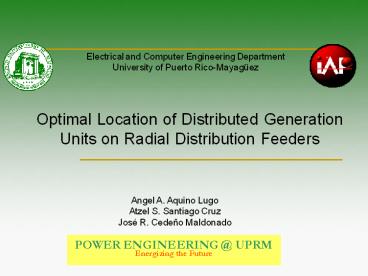Optimal Location of Distributed Generation Units on Radial Distribution Feeders - PowerPoint PPT Presentation
1 / 22
Title:
Optimal Location of Distributed Generation Units on Radial Distribution Feeders
Description:
Electrical and Computer Engineering Department University of Puerto Rico-Mayag ez Optimal Location of Distributed Generation Units on Radial Distribution Feeders – PowerPoint PPT presentation
Number of Views:755
Avg rating:5.0/5.0
Title: Optimal Location of Distributed Generation Units on Radial Distribution Feeders
1
Electrical and Computer Engineering
Department University of Puerto Rico-Mayagüez
- Optimal Location of Distributed Generation Units
on Radial Distribution Feeders
Angel A. Aquino Lugo Atzel S. Santiago Cruz José
R. Cedeño Maldonado
POWER ENGINEERING _at_ UPRM Energizing the Future
2
Overview of Distributed Generation Presentation
1. Central Distribution
2. Distributed Generation
4. Research in Distributed Generation
- 3. DG Technologies
3
The present power system follows a conventional
structure
Back-up
Load
Transmission
Distribution
- 200 hours per year limit
- Exempt from emissions regulations
- Not interconnected
- Does not support the grid but operates after the
grid has failed
- 100,000 /mile
- 6-7 electric losses
- Difficult to obtain right-of-ways
- 400-500/KW
- Difficult to permit
Generation
4
Vulnerabilities of Conventional Power Systems
- High power losses
- Service Reliability
- Quality of Service
- Permits for construction of infrastructure
- Environmental impacts and emissions
New York City during the blackout of August 14,
2003
Cars stopped at a ride at Cedar Point Amusement
Park in Ohio. Riders were stranded on the roller
coaster for 20 minutes.
5
Distributed Generation (DG) Definition
- Small-scale generation that provides electric
power at or near the load site - Interconnected to the utility distribution system
and/or directly to the customers facilities - Typically 10MW capacity or less
6
DG Potential Benefits
- Sitting of DG at or near end-use locations will
provide the following important advantages. - Increase local and/or system-wide utility service
reliability. - Reduce transmission and distribution line losses
- Reduce environmental impacts and emissions.
- Provide new utility products and services.
7
DG Limitations Considerations
- Low Voltage profile if DG is placed near
transformer bus. - Voltage flicker noticeable to customers.
- Introduction of harmonics cause by power
converter on interconnection point. - DG can alter the short circuit levels causing
fuse-breaker miscoordination. - Voltage swells and overvoltages.
8
DG Technologies
Wind Turbines
9
Research Objectives
- Determine the impact of Distributed Generation on
actual power systems - Determine the best location of distributed
generators so that the real power losses on the
distribution network is obtained - The best location of distributed generators so
that an optimum voltage profile on the
distribution network is obtained
10
Power Losses
- DG units will impact both the real and reactive
power flow. - The addition of DG units may cause an increase in
power losses. - Finding the best location where power losses are
minimized counteract the previous problem.
11
Voltage Profile
- Different techniques are used to maintain the
voltage magnitude at the load within specified
limits. - Distributed Generation introduces meshed power
flows that interfere with the effectiveness of
standard voltage regulation practice. - With DG weaker feeders that have a very low
voltage level will benefit from an increased
voltage level.
12
22 bus test feeder system
- SKM Power Tools simulation (PTW32)
- Based on a 22 buses test feeder configuration
- Simulation using trial and error on each bus to
find the best voltage profile and to minimize
losses.
13
22 Bus feeder
- DG installation impact modeled
- Nodal voltage and losses recorded
- The further the DG unit was placed from utility
the better the results - DG at Node 22 provides the best results
14
22 Bus feeder
15
22 Bus feeder
16
28 bus test feeder system
- SKM Power Tools simulation (PTW32)
- Based on a 28 buses test feeder configuration
- Same methodology as on the previous feeder
17
28 Bus feeder
- DG installation impact modeled
- Nodal voltage and losses recorded
- Results are similar to those obtained on the 22
buses feeder - Placing the DG unit further from the utility
yielded better results - DG at Node 26 provides the best results
18
28 Bus feeder
19
28 Bus feeder
20
Research Conclusions
- The best location for distributed generation
units so that an optimum voltage profile in the
distribution network is obtained depends on the
complexity and shape of the system. - For a balanced system the farther the generator
is located from the utility the better the
improvement in voltage profile. - The losses will also be minimized at that
location. - Varying the location of the generator has an
impact on the system.
21
Conclusion Distributed Generation
- DG provides benefits to the system
- DG still has limitations that must be addressed
- DG a relatively new technology with many research
opportunities - DG is the future for power generation.
22
- QUESTIONS???

